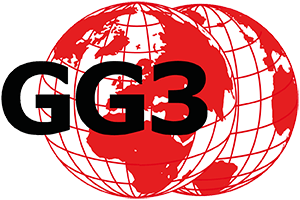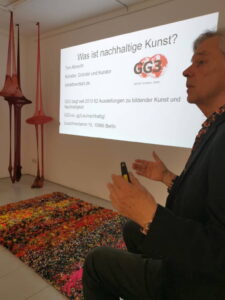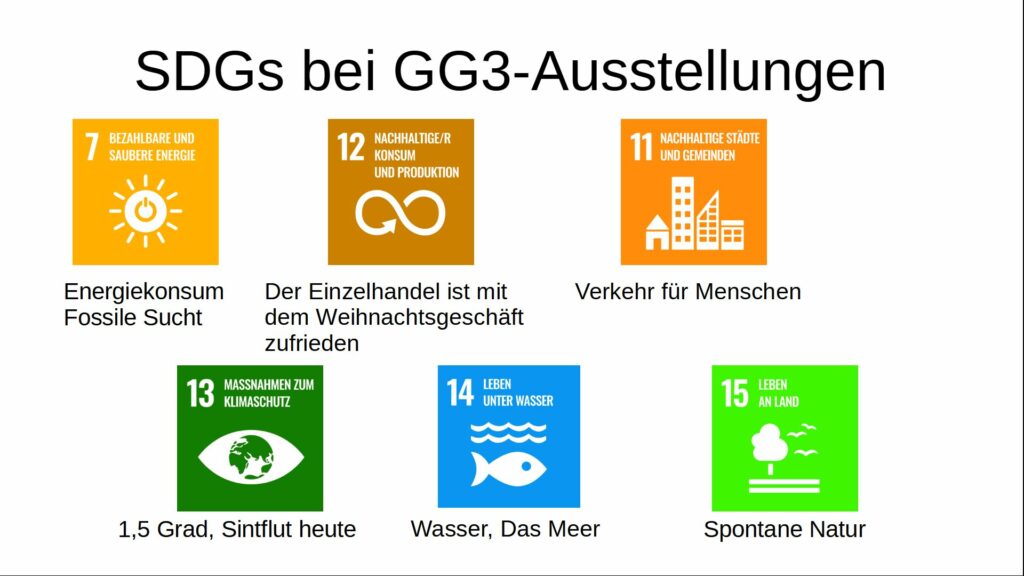Lecture by Tom Albrecht with workshop for guests and artists as part of the exhibition “Leichtfüßig, 10 Jahre Kunst der Nachhaltigkeit”, Berlin, 3.11.2023
What is sustainable art?
- Art whose practitioners practice sustainability in theme, material, and location.
- Reduces your own ecological footprint.
- Increases the ecological handprint through impact on society,
- Is accessible, dialogic,
Uses exhibitions, website, mailing, press
“Do good and talk about it”, - Practices consistency and credibility,
Economic, social and ecological sustainability go hand in hand.
Germany has the greatest ecological deficits: Climate protection, species extinction.
In international comparison, Germany is considered to be a largely functioning state in economic and social terms.
Solving deficits with a focus on the ecological, combined with the social and economic.
Motifs for sustainable art
- Climate change and species extinction are major social challenges, locally, nationally and globally.
- The linear dialog between the press and science is reaching its limits.
- Art is a source of social impetus here.
- Art can touch, stimulate the imagination, move solutions through associations.
- Voluntary process. Reasons can be concerns about the world, passing on experiences, influencing society
Sustainable art is political
Art can be political: In the tradition of John Heartfield, founder of political photomontage; Otto Dix, anti-war glorifying; Picasso’s Guernica protests against war and destruction.
Art politically addresses ecology: Joseph Beuys is open to criticism, but planted 7000 oaks, “Urban Forestation Instead of Urban Administration,” as a sign against the destruction of nature. The Berlin artist Ben Wargin, for example, installed the Parliament of Trees in the new government district.
Sustainable art supports the 17 Sustainable Development Goals as political objectives of the United Nations (UN), which are intended to ensure sustainable development on an economic, social and ecological level worldwide.
SDGs at GG3 exhibitions
Three areas belong together
- The operation of the art venue, e.g. its CO² product. For artists, the material they use, their business
- The theme of the exhibitions, the works
- The public for guests, advertising
Operation of the exhibition venue
Establish a Green Team, formulate a mission statement
Record consumption values
Savings potential for electricity for lighting and devices? Lighting concept
Heating of exhibition and workspaces: shock ventilation, room temperature
Printing orders, e.g., recycled paper
Waste separation, waste avoidance
Ecological service providers: catering, provider, bank
Reuse packaging
Kitchenette coffee machine
Operation: Networking
Gallery Climate Coalition (GCC) is an international non-profit community of arts organizations committed to reducing the environmental impact of their sector.
The GCC’s primary goal is to reduce its CO 2 emissions by at least 50% by 2030 and to promote zero waste.
Members are artists, commercial and non-commercial art institutions.
Offer CO2 calculator, best practice guidelines, campaigns
“Sustainability Action Network” Focus on operational ecology, trains consultants, certificate, e.g. museums with air conditioning, theaters
Offers from GG3 on gg3.eu under “Gallery”, “Sustainable”: Mission statement,
Sustainability check for project spaces, sustainability as a theme for artworks and exhibitions, sustainability for visual artists, sustainability for commercial galleries
Material of the artists:Inside
As a gallery, encourage the use of sustainable materials
For example, the exhibition “Light-footed” requires a small ecological footprint for the artwork.
The organizer expresses the wish that the artists use sustainable materials.
gg3.eu/nachhaltigkeit-fuer-bildende-kuenstlerinnen/
He refers to material sources such as HDM, Kunststoffe e.V.
Requests postal delivery instead of artists’ personal arrival.
Arrival e.g. by train instead of flight
Sustainability in the topic
From current social discussion
Works e.g. Thomas Behling “Map of Berlin” (detail)
GG3 – Exhibitions:
after the disaster in the Ahr Valley: “Deluge Today”
“Farmer Seeks Industry” Species extinction
“Cargo” Traffic for goods, delivery services
“Light-footed” small ecological footprint. Footprint of the works
Intentions
Create images for abstract concepts
Wants to change, gets involved
can help to encourage movement
seeks topicality
addresses problems
Picking up where science ends
Dystopian with a window of hope
Art venue: gallery, project space, museum, studio, collection, outdoors
The public
People seek answers to the crises
A credible opportunity for art to move people
Inform guests about public transport connections rather than car parking options.
Join the GCC
Showcase one’s commitment on one’s own website
Advertise on sustainable websites
e.g. gemeinschaftswerk-nachhaltigkeit.de
GG3 has resonance: Radioeins, Creative City Berlin, Art next Door, Prolog, RBB Kultur, Senate Prize, TAZ, bpigs, 1000 Interwievs, coinspiration, Zeitschrift für Kultur
Movement for more sustainability in art venues is happening slowly
- Big places like museums are starting to move. Reduce energy costs, support federal government, sustainability action network, e.g. energy consulting for theaters, train transformation managers.
- Kommunale Galerien Berlin: The working group organized a conference on the NH.
- Commercial galleries Berlin: 2022 competition by the Berlin Senate of Economics, galleries show very different levels of commitment
- Art academies: Weissensee School of Art has a sustainability mission statement, Berlin University of the Arts has a climate protection concept for operations and teaching.
The process is too slow. The focus is on operations, but not on research and teaching.
Workshop
“Problem Bubble”: How can sustainable art generate more impact?
Lecturer
Tom Albrecht
Artist, founder and curator
tomalbrechtart.de
GG3 has shown 62 exhibitions on visual arts and sustainability since 2013
GG3.eu, gg3.eu/nachhaltig/
Leuschnerdamm 19, 10999 Berlin


